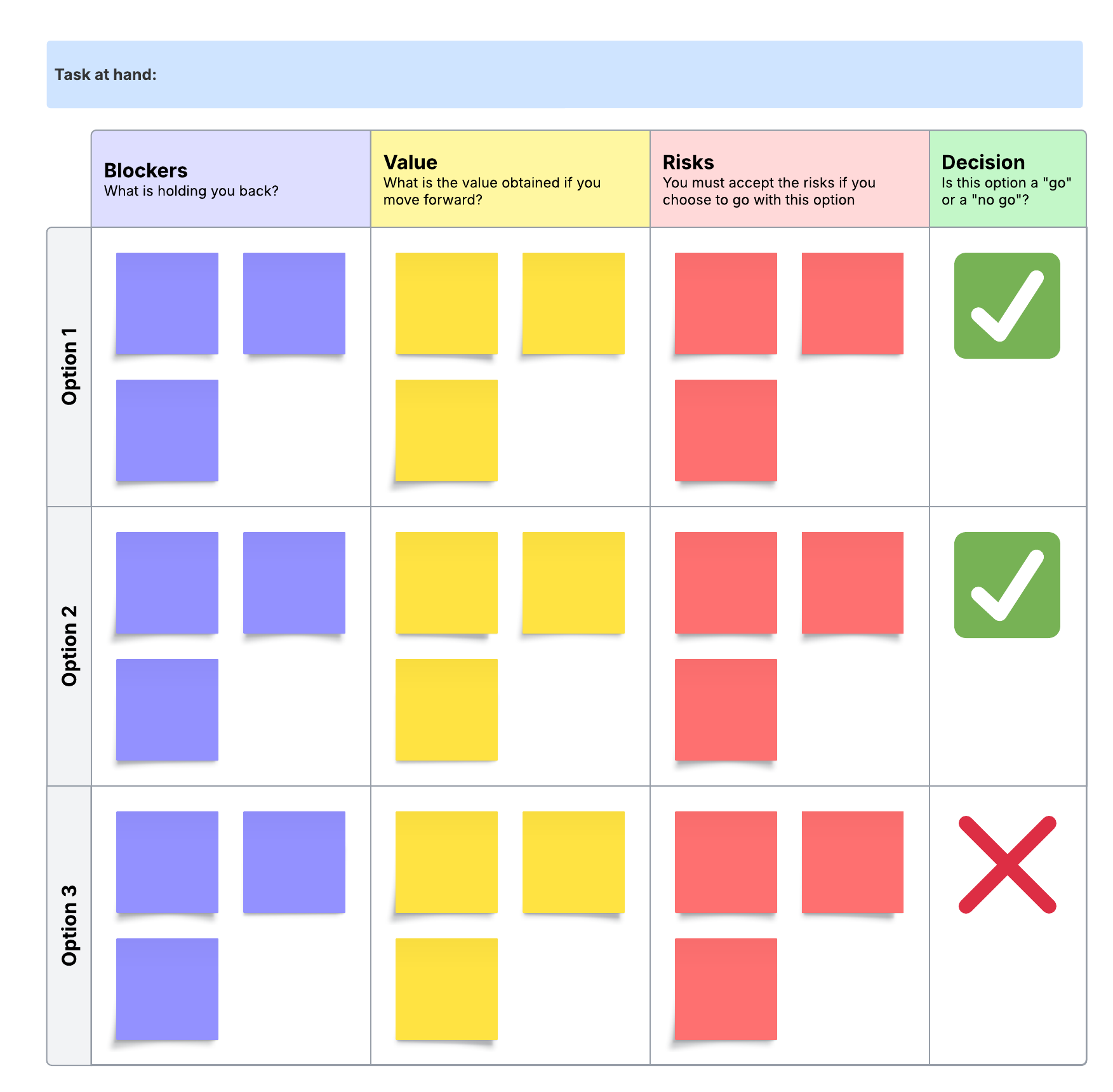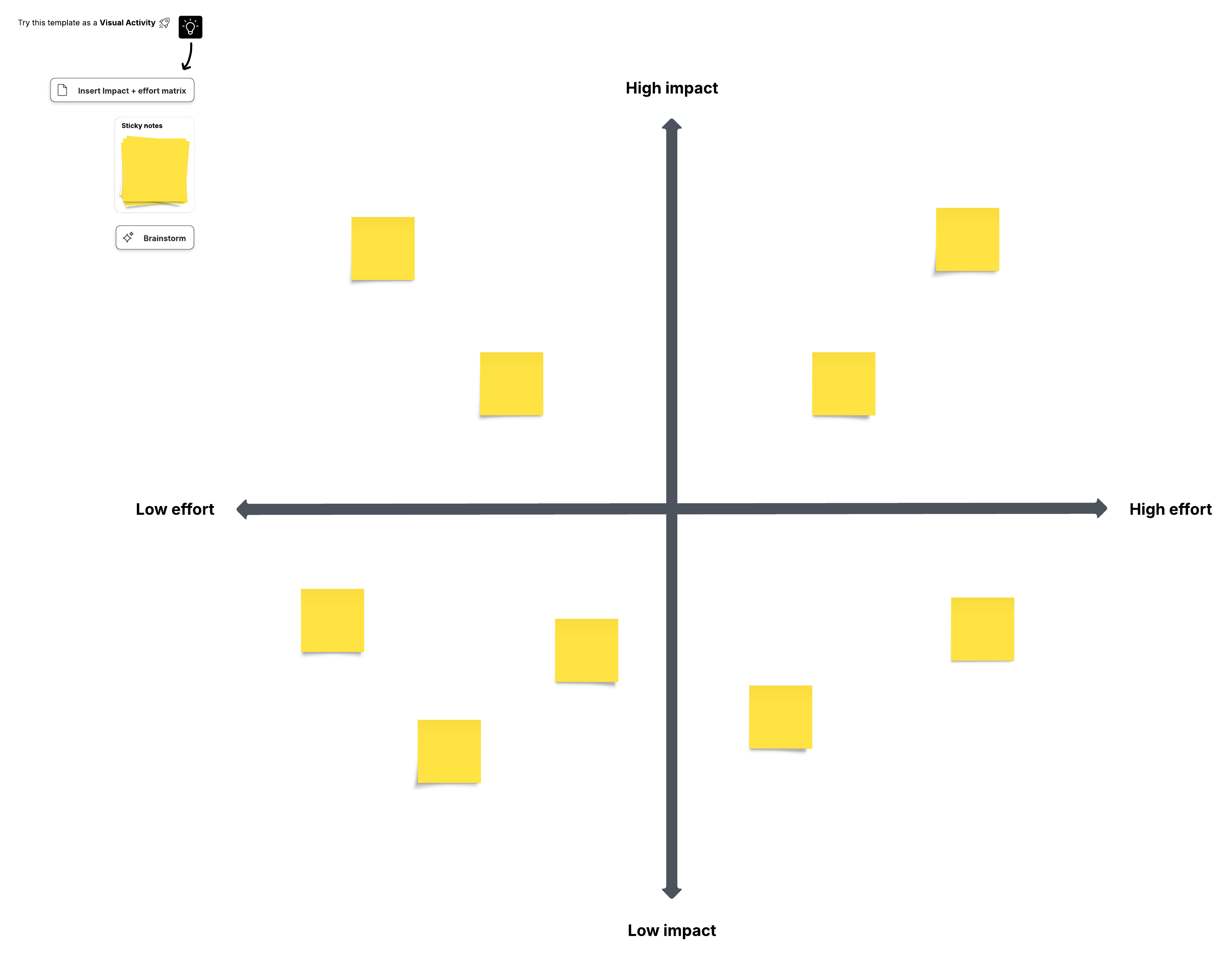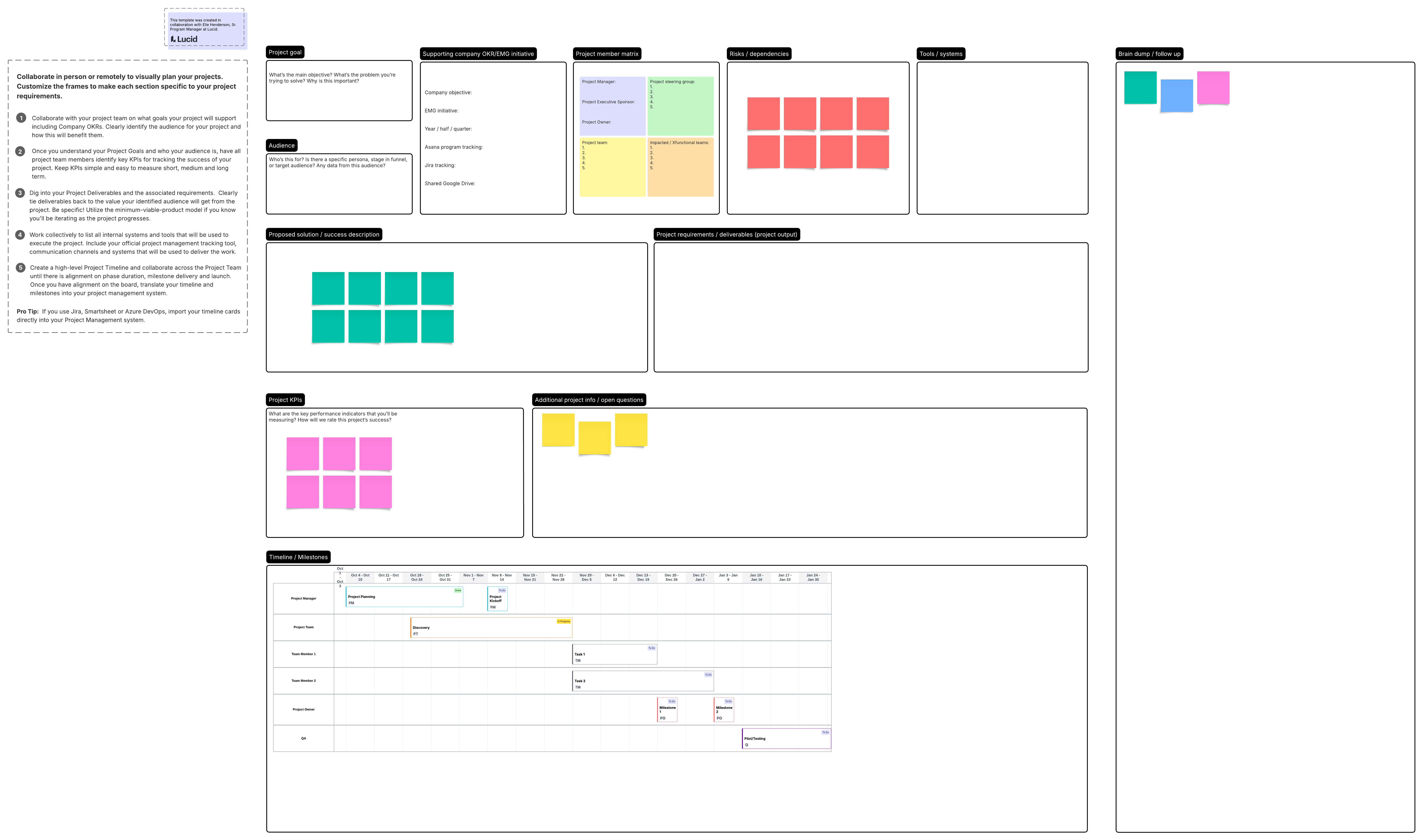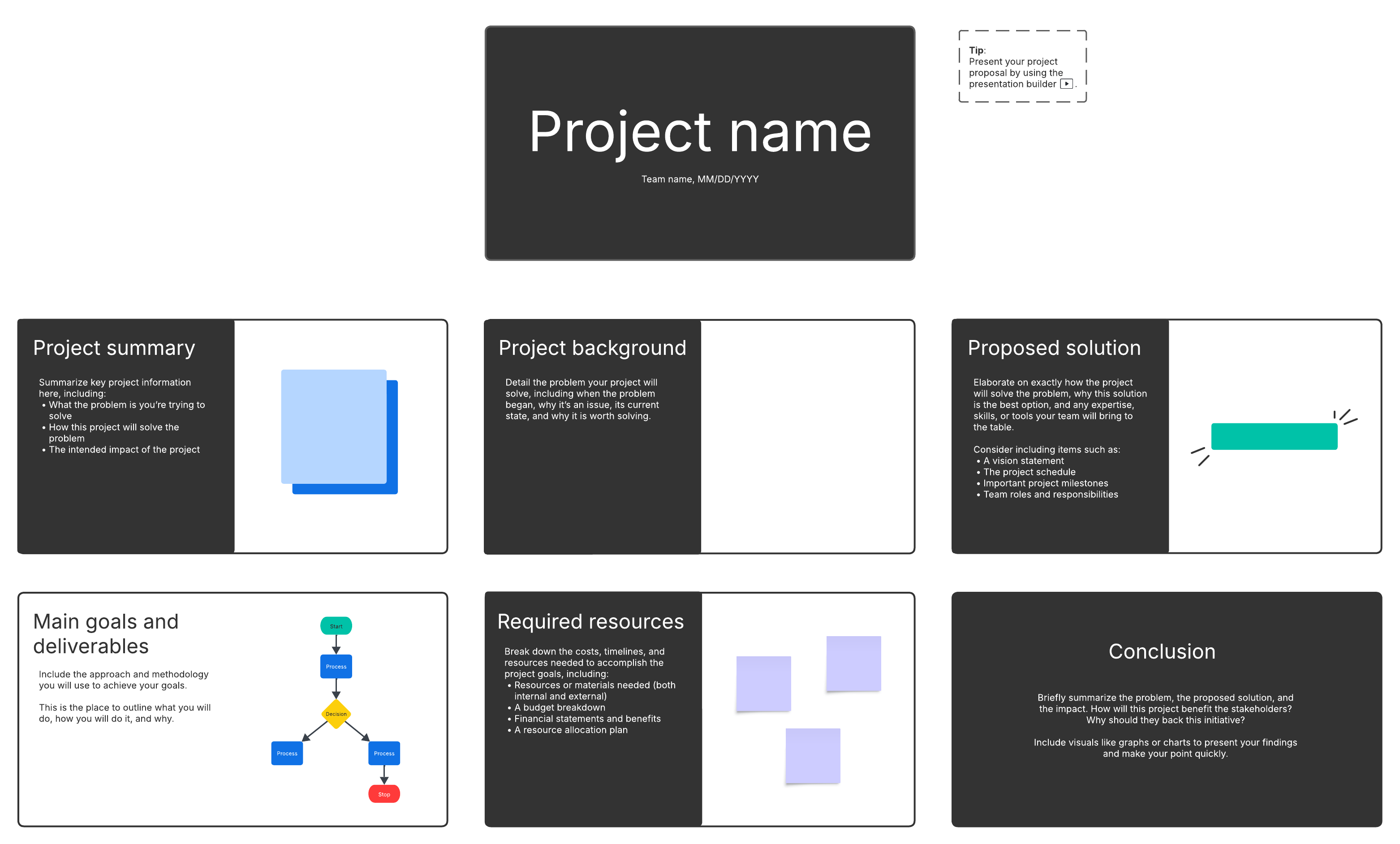
How to prioritize ideas after a successful brainstorming session [+ templates]
Reading time: about 6 min
Topics:
Your last brainstorming session was spectacular. You came prepared with the problem you wanted to solve, effortlessly facilitated the brainstorm, ensured that all voices were heard, and asserted just the right amount of pressure to get the ideas flowing. You left the meeting energized by the ideas presented and delighted to be part of such a creative team.
But that was a week ago, and not much has happened since. What do you do?
While conducting a brainstorming session presents its own challenges, what happens after the session separates the brainstorming warriors from the newbies. Effective brainstorms yield clear action items for you and your team to move forward with.
In this article, we'll teach you how to capitalize on the momentum you generate from your productive brainstorming session and move forward with clarity.
What’s next: Prioritization and organization
Once you’ve finished facilitating your brainstorming session, it's time to organize and prioritize your ideas.
Brainstorming sessions often generate a large number of ideas, and they can be chaotic and unstructured. Organizing your ideas helps clarify the process by categorizing and grouping related concepts. It lets you see the bigger picture and identify the most promising ideas. When you categorize ideas, you also may start to see different trends emerge, making it easier to make a decision than you may think.
Additionally, organizing your ideas after a brainstorming session allows you to document them systematically. This documentation is valuable for future discussions, decision-making, and problem-solving. It ensures that ideas are not lost or forgotten over time.
Once ideas are organized, developing an action plan for implementing them becomes easier. You can identify the necessary resources, potential challenges, and steps to turn the ideas into tangible outcomes. Organized ideas provide a roadmap for execution.
Different ways to prioritize ideas
Organizing your ideas lets you evaluate and prioritize them based on their relevance, potential impact, and feasibility. This ensures that you focus on the most important and actionable ideas first. Here’s how to organize the ideas your team has generated:
Voting
Voting is a great way to get the whole team involved in decisions and increase buy-in. In Lucid, you can set up a voting session by selecting the voting box icon (it looks like a little ballot box with a star) at the top of your document.
Rank ideas
Reach a consensus on how best to move forward with Visual Activities . These simple, customizable activities allow you to identify, sort, and prioritize team ideas in seconds.
Another great way to rank team ideas is with Lucid's free templates. This decision-making template, for example, helps you differentiate options by assessing blockers, value, and risk.

The impact effort matrix is a simple template that helps you visually prioritize and align priorities by comparing their potential effort and impact.

The 6:1 idea tool template guides you in ranking ideas by categorizing them uniquely. While ranking ideas, don’t forget to consider cost, risk, timelines, value, and urgency.

Make a decision
Regardless of how you reach your conclusion, at some point, you need to make a decision. Be sure to maintain documentation of your process so you can still access the other ideas if you need to pivot or access them later. A systematic approach to decision-making can look like this:
Define the decision
Clearly articulate the decision you need to make. Identify the problem, goal, or situation that requires a decision. The more specific and well-defined the decision, the easier to make an informed choice.
Gather information
Consider all the options generated from your brainstorm. You also want to understand the factors influencing the decision comprehensively.
Evaluate the alternatives
Assess the pros and cons of each alternative. Consider the potential outcomes, risks, benefits, and costs. Utilize critical thinking and objective analysis to evaluate each alternative's feasibility and potential impact.
Make a choice
Based on the evaluation of the alternatives, make a decision by selecting the option that aligns best with team goals, values, and priorities.
It's important to note that decision-making is not always a linear process, and some steps may overlap or require iteration. Additionally, the complexity of decisions may vary, with some requiring more extensive analysis and consultation than others.
Create a plan
Once a decision is made, your job isn’t over. It’s up to you and your team to organize actionable steps and maintain the momentum of the successful brainstorming session. Here’s how to do it:
- Set goals: Create clear goals and articulate the specific outcome you want to achieve. Ensure your goal is specific, measurable, achievable, relevant, and time-bound (SMART). This clarity will guide your planning process.
- Create documentation for stakeholders: Good documentation is key to aligning with stakeholders and keeping projects moving forward. If the thought of documentation seems daunting, we’ve got templates to help. Additionally, consider using team spaces to give everyone a home base to coordinate work, get the context they need, and collaborate effortlessly.
- Create a project timeline: Cut the confusion on when deliverables are due with a project timeline. This will keep everyone aligned and ensure you meet deadlines.
- Present the plan: Present your plan to stakeholders to make sure everyone is on the same page. Within your Lucid document, you can build stellar presentations with Presentation Builder. Simply select the Presentation Builder icon from the right-hand corner of your board. Click +Add New Slide to add as many slides as you’d like.
Now that everyone is on board, it’s time to. build out a project proposal, share relevant resources, take questions, secure buy-in, and assign tasks.
Following these steps and syncing regularly will help ensure that powerful brainstorming sessions don't go to waste.

Make a choice
Based on the evaluation of the alternatives, make a decision by selecting the option that aligns best with team goals, values, and priorities.
It's important to note that decision-making is not always a linear process, and some steps may overlap or require iteration. Additionally, the complexity of decisions may vary, with some requiring more extensive analysis and consultation than others.
Create a plan
Once a decision is made, your job isn’t over. It’s up to you and your team to organize actionable steps and maintain the momentum of the successful brainstorming session. Here’s how to do it:
1. Set goals: Create clear goals and articulate the specific outcome you want to achieve. Ensure your goal is specific, measurable, achievable, relevant, and time-bound (SMART). This clarity will guide your planning process.

2. Create documentation for stakeholders: Good documentation is key to aligning with stakeholders and keeping projects moving forward. If the thought of documentation seems daunting, we’ve got templates to help. Additionally, consider using team spaces to give everyone a home base to coordinate work, get the context they need, and collaborate effortlessly.

3. Create a project timeline: Cut the confusion on when deliverables are due with a project timeline. This will keep everyone aligned and ensure you meet deadlines.

4. Communicate the plan: Present your plan to stakeholders to make sure everyone is on the same page. Within your Lucid document, you can build stellar presentations with Presentation Builder. Simply select the Presentation Builder icon from the right-hand corner of your board. Click +Add New Slide to add as many slides as you’d like.
Now that everyone is on board, it's time to develop a project proposal, share relevant resources, answer questions, secure buy-in, and assign tasks.

Following these steps and syncing regularly will help ensure that powerful brainstorming sessions don't go to waste.

Ready to master the prioritization process? Explore our guide to prioritization matricies.
Read nowAbout Lucid
Lucid Software is the leader in visual collaboration and work acceleration, helping teams see and build the future by turning ideas into reality. Its products include the Lucid Visual Collaboration Suite (Lucidchart and Lucidspark) and airfocus. The Lucid Visual Collaboration Suite, combined with powerful accelerators for business agility, cloud, and process transformation, empowers organizations to streamline work, foster alignment, and drive business transformation at scale. airfocus, an AI-powered product management and roadmapping platform, extends these capabilities by helping teams prioritize work, define product strategy, and align execution with business goals. The most used work acceleration platform by the Fortune 500, Lucid's solutions are trusted by more than 100 million users across enterprises worldwide, including Google, GE, and NBC Universal. Lucid partners with leaders such as Google, Atlassian, and Microsoft, and has received numerous awards for its products, growth, and workplace culture.
Related articles
6 practical tips for more efficient collaboration
Here are some tangible ways to increase the efficiency and effectiveness of your team's collaboration.
How improving the way you collaborate benefits your business goals
Learn how improving collaboration across your organization can help increase alignment, efficiency, agility, and innovation—and even reduce costs.
What to do after a brainstorming session
Knowing what to do after a brainstorming session is often more important than getting together to ideate in the first place. If you want to turn a brainstorm into workable ideas, here are some great ways to get started.
7 tips for improving your brainstorming sessions
With a few must-haves and some basic guidelines, you’ll learn how to increase the effectiveness of your brainstorming meetings in no time.
